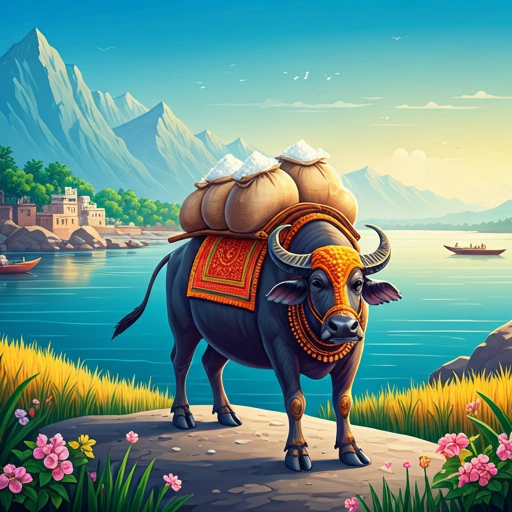
In the fertile plains of northern India, where the air hummed with the chants of wandering sadhus and the scent of jasmine hung heavy in the warm air, there lived a water buffalo named Bhima. His life was one of patient service, his days spent transporting goods for the villagers who depended on him. On this particular day, he carried sacks of coarse salt crystals, each grain a tiny burden contributing to the larger weight of responsibility he bore for his community. The sun, a benevolent yet powerful presence, cast long shadows across the fields as Bhima plodded along the well-worn path.
“A long day, and a heavy load,” Bhima rumbled softly, his breath misting in the cool morning air. His voice, deep and resonant, was almost lost in the rustling of the rice paddies that bordered the path. “Will this journey ever end?” He shifted the weight on his broad back, the rough burlap of the sacks rubbing against his thick hide.
As he continued his journey, the path led him to the banks of the sacred Ganges. The river, a wide, flowing expanse of water, shimmered under the morning sun. Its surface reflected the sky like a vast, moving mirror, and its gentle murmur filled the air with a sense of ancient wisdom. The Ganges was more than just a river; it was a life force, a sacred entity, revered by all who lived along its banks. Bhima paused at the water’s edge, a deep respect filling him as he gazed at the flowing water. Crossing it was not a simple matter; it was a passage, a symbolic step into the unknown. But the villagers awaited the salt, and Bhima knew he must continue.
With a deep breath, he began to wade into the river. The cool water enveloped his legs, a welcome relief from the long walk. He moved slowly and carefully, his hooves finding purchase on the smooth stones of the riverbed. But midway across, a submerged log, hidden beneath the murky water, shifted under his weight. With a startled bellow, he stumbled, the sacks of salt plunging into the river.
For a moment, chaos reigned. The water swirled around him, the current tugging at his legs, and a surge of panic gripped him. But as he struggled to regain his footing, a remarkable transformation occurred. The salt, dissolving rapidly in the sacred water, vanished, becoming one with the Ganges itself. Bhima felt an immediate and profound lightness.
“What…?” he breathed, his voice filled with surprise as he stood, now steady, on the riverbed. “The weight…it’s gone.” A sense of liberation, both physical and emotional, washed over him. He felt as if a burden he had carried for many lifetimes had been lifted.
He emerged from the river onto the opposite bank, his steps light and free, a sense of joy filling his heart. Yet, within this joy, a subtle seed of overconfidence took root, a dangerous assumption that all burdens could be so easily resolved, that the Ganges held a magical solution to every difficulty.
Some days later, his route took him once again to the banks of the Ganges. This time, his load was different: sacks filled not with salt, but with bales of raw cotton—light and airy, seemingly insignificant compared to the dense salt he had previously carried.
As he approached the river, the memory of his previous liberation, the feeling of weightlessness, returned with vivid clarity. The Ganges seemed to offer the same promise of release. “If the river freed me before,” Bhima mused aloud, his voice echoing across the still water, a quiet conversation with himself and the ancient river, “surely it will do so again.”
Without hesitation, without considering the fundamental difference between salt and cotton, he waded into the river and, remembering his previous experience, intentionally allowed himself to fall. But this time, the result was disastrous. The cotton, instead of dissolving, absorbed the water greedily, becoming saturated and incredibly heavy, clinging to him like a suffocating blanket.
“What have I done?” Bhima cried out, his voice strained with fear and exertion as he struggled against the combined forces of the current and the immense weight. Each step was a monumental effort, each breath a struggle against the suffocating mass.
The Ganges seemed to whisper a profound lesson, not in words, but in the sensations that permeated his being: “Not all burdens are resolved through dissolution. Some require a different kind of engagement, a deeper understanding of their nature.”
With immense effort and considerable suffering, he finally managed to reach the riverbank, his body exhausted, his spirit humbled. He looked back at the sodden, heavy bales clinging to his back, and the weight of his foolish assumption pressed down on him even more heavily than the cotton itself. He understood, finally, the crucial lesson the Ganges had offered: what we carry shapes us, not just in its physical form, but in how we choose to engage with it, how we learn from it, and how we allow it to transform us.
————
Existential Meaning:
This tale explores the complexities of human experience, the constant tension between ease and effort, between release and responsibility. The Ganges represents the flow of life itself, a constant current of change, challenge, and opportunity. It does not judge our burdens, but it reveals their true nature when we interact with its currents. The dissolved salt signifies burdens that are external, imposed by circumstance or misconception, and these can be released through awareness, courage, and a willingness to let go. However, the waterlogged cotton represents burdens that are internal, rooted in our choices, our attachments, our misunderstandings, and our pride. These inner burdens cannot be simply washed away; they require a different kind of work—introspection, self-awareness, and a willingness to confront our own limitations.
The deeper wisdom of the tale lies in the understanding that true liberation is not about avoiding burdens altogether, but about cultivating the wisdom to discern their true nature. It is about learning to distinguish between what can be released and what must be carried with intention, acceptance, and a willingness to learn. It is through this process of discernment and conscious engagement with life’s currents that we develop resilience, discover deeper meaning, and cultivate lasting inner peace.
